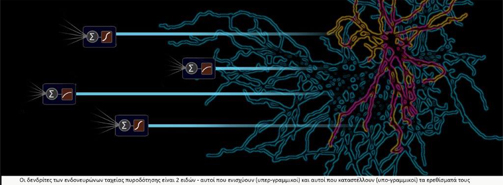All Science News
Researchers at IMBB-FORTH challenge the dogma that wants interneurons to be “simple”.
Computational modeling in the Poirazi lab (www.dendrites.gr) at IMBB-FORTH (www.imbb.forth.gr) shed new light on how Fast Spiking Basket Cells – a central subtype of GABAergic inhibitory neurons- integrate their incoming signals, taking advantage of their recently discovered dendritic non-linearities. The article, entitled: “Challenging the point neuron dogma: FS basket cells as 2-stage nonlinear integrators” authored by IMBB researchers Alexandra Tzilivaki, George Kastellakis and Panayiota Poirazi was recently published in the scientific journal Nature Communications.

Interneurons are the main inhibitory class of cells in the brain of mammals. They come in many flavors, varying in shape, localization, connectivity and intrinsic properties. Despite this variability, they are mainly attributed a simple task: to maintain the excitation / inhibition balance necessary for normal brain functioning. Indeed, disruption of their proper functioning is associated with several neurodegenerative disorders such as Alzheimer’s, Parkinson’s, epilepsy etc.
For decades, interneurons were assumed to sum their inputs and, if strong enough, cause the cell to fire. This simple type of computation, also referred to as a “point neuron” computation, ignores any non-linear influences that could be generated in the dendrites of these cells. Recent experimental findings however, report nonlinear dendritic events in many interneuron subtypes, implying that interneurons may be much more than simple point devices.
To test this proposition, the researchers developed a toolset of computational models covering two brain areas related to learning and memory functions, the hippocampus and the prefrontal cortex. This toolset consisted of a) full-blown morphologically and biophysically detailed models of Fast Spiking Basket Cells (FSBCs), b) mathematical reductions of these cells in the form of artificial neural networks and c) a network model with both excitatory and inhibitory cells, able to form new associative memories. They used these models to test how FSBCs integrate at the single neuron level and how their computational properties may affect learning and memory.
The first interesting finding was that in all model cells tested, in both brain areas, FSBCs had non-linear dendrites. Depending on their morphology and biophysics, these dendrites could either boost incoming inputs (supra-linear dendrites) or suppress them (sub-linear dendrites). The presence of these non-linearities enabled individual FSBCs to produce a wide range of responses that could not be captured by a point neuron reduction. Instead, the researchers showed that the best way to capture what an FSBC is actually computing was to assume a 2-layer Artificial Neural Network that incorporates the two types of dendrites, found in these cells: supra-linear and sub-linear. This finding raises this particular interneuron subtype to the same level of processing power as pyramidal neurons, the main excitatory neurons involved in most complex behaviors, including learning and memory.

Taking it one step further, the researchers implemented a network model with both excitatory and inhibitory neurons, capable of forming associative memories. They showed that the nonlinear dendrites of FSBCs can significantly enhance learning and memory in this network model, compared to a respective network with only point FSBCs (implemented with linear dendrites). This prediction shows the wider implications of considering dendritic nonlinearities in interneurons, a deed that has been ignored for years.
In summary, this work provides a novel view of dendritic integration in FS interneurons that extends in hippocampal and cortical areas. It also provides a more accurate reductionist description of interneuron processing that may have substantial influences in fields beyond Neuroscience, including machine learning and artificial intelligence. Further experimental testing will broaden our understanding of how interneurons exploit their complex dendritic processing capabilities so as to contribute to complex brain functions.
Publication:
Tzilivaki A., Kastellakis G., Poirazi P. (2019) Challenging the point neuron dogma: FS basket cells as 2-stage nonlinear integrators. Nature Communications. doi: 10.1038/s41467-019-11537-7
https://rdcu.be/bOQgU
For more information, please contact Dr. Panayiota Poirazi
Research Director, IMBB‐FORTH
Email: poirazi@imbb.forth.gr
Tel.: +30 2810391139
www.dendrites.gr








